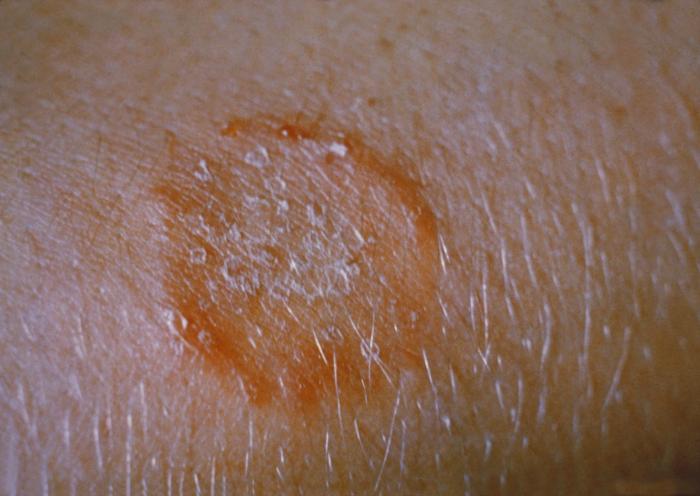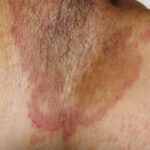Tinea corporis is a superficial dermatophyte infection of the glabrous (non-hairy) skin, excluding the scalp, groin, palms, and soles. Commonly known as ringworm of the body, this condition is characterized by annular, erythematous, and scaly plaques that typically expand outward. It is highly contagious and affects individuals of all age groups globally.

Etiology: Understanding the Cause of Tinea Corporis
Tinea corporis is caused by keratinophilic fungi known as dermatophytes, primarily from three genera:
- Trichophyton
- Microsporum
- Epidermophyton
The most frequently implicated species include:
- Trichophyton rubrum
- Trichophyton mentagrophytes
- Microsporum canis (often zoonotic)
Transmission can occur via:
- Direct skin-to-skin contact with infected individuals or animals
- Indirect contact through contaminated clothing, towels, or surfaces
- Autoinoculation from another infected site (e.g., tinea pedis spreading to the body)
Risk Factors and Populations at Higher Risk
Certain environmental and personal factors significantly increase susceptibility:
- Hot, humid climates
- Excessive sweating
- Immunosuppression (e.g., diabetes, HIV, steroid use)
- Participation in contact sports
- Close-contact living situations
Children, athletes (particularly wrestlers), and individuals with poor hygiene practices are especially vulnerable.
Recognizing Tinea Corporis Symptoms and Clinical Presentation
Tinea corporis typically manifests as well-demarcated, annular plaques with central clearing and an active, scaly border. The rash may vary in appearance based on severity and immune response.
Common Symptoms:
- Round or oval, red, scaly patches on the skin
- Central clearing with an advancing edge
- Itching or burning sensation
- Lesions that may coalesce into large plaques
- Vesicles or pustules on the border in inflammatory variants
In immunocompromised patients, the infection may be more extensive, atypical, and resistant to treatment.
Variants of Tinea Corporis
Several distinct variants exist, which may alter clinical appearance and treatment approach:
- Tinea corporis gladiatorum: Found in wrestlers and athletes
- Majocchi’s granuloma: Deep follicular infection, especially in immunocompromised
- Tinea imbricata: Concentric rings, caused by T. concentricum, common in the South Pacific
- Tinea incognito: Atypical presentation due to inappropriate corticosteroid use
Differential Diagnosis: Conditions That Mimic Tinea Corporis
Several dermatologic conditions can resemble tinea corporis, making clinical differentiation essential:
- Nummular eczema
- Psoriasis
- Pityriasis rosea
- Cutaneous lupus erythematosus
- Erythema annulare centrifugum
Definitive diagnosis requires clinical correlation with mycological tests.
Diagnostic Approach to Confirm Tinea Corporis
Accurate diagnosis ensures effective management and avoids unnecessary treatments.
Diagnostic Tools:
- KOH Preparation: Skin scraping examined under a microscope to detect fungal hyphae
- Fungal Culture: Identifies the specific dermatophyte species
- Wood’s Lamp: May show fluorescence in Microsporum infections
- Skin Biopsy (rare): Used when diagnosis remains uncertain
Prompt diagnosis is crucial in recurrent, resistant, or widespread infections.
Treatment Protocols for Tinea Corporis
Treatment is based on the extent, severity, and response to therapy. Most uncomplicated cases respond well to topical antifungals, but systemic therapy is often required for widespread or recurrent infections.
Topical Antifungal Agents (for localized cases):
- Clotrimazole
- Terbinafine
- Miconazole
- Ketoconazole
- Econazole
Apply twice daily for 2 to 4 weeks, extending treatment 1 week beyond resolution.
Oral Antifungal Therapy (for extensive or refractory cases):
- Terbinafine 250 mg/day for 2–4 weeks
- Itraconazole 100–200 mg/day for 1–2 weeks
- Fluconazole 150–300 mg weekly for 2–4 weeks
- Griseofulvin 500–1000 mg/day for 4–8 weeks
Adjunctive Measures:
- Maintain dry and clean skin
- Avoid occlusive clothing
- Disinfect contaminated items
- Treat coexisting tinea infections (e.g., pedis or unguium)
Prevention Strategies and Public Health Considerations
Prevention plays a key role in controlling outbreaks, particularly in close-contact environments.
Personal Hygiene Recommendations:
- Avoid sharing personal items
- Bathe regularly, especially after sweating
- Use antifungal powder in humid conditions
- Examine and treat household pets for dermatophyte infection
Community Measures:
- Routine screening of athletes
- Disinfection of shared equipment in gyms
- Health education in schools and sports facilities
- Isolation of infected individuals until treated
Prognosis and Recurrence
Tinea corporis generally has an excellent prognosis with appropriate therapy. However, relapse is common if the underlying source remains untreated or environmental conditions persist.
Factors contributing to recurrence include:
- Incomplete treatment
- Misdiagnosis or inappropriate corticosteroid use
- Immunosuppression
- Untreated reservoirs (e.g., tinea pedis, pets)
Summary: Key Takeaways on Tinea Corporis
- Tinea corporis is a highly contagious fungal skin infection caused by dermatophytes.
- Presents as ring-shaped, scaly, itchy lesions on the body.
- Diagnosis is confirmed with KOH microscopy or culture.
- Treated effectively with topical or oral antifungals depending on severity.
- Proper hygiene and prevention are essential to control spread and recurrence.
Frequently Asked Questions:
What causes tinea corporis?
Tinea corporis is caused by dermatophyte fungi like Trichophyton rubrum that infect the outer layer of the skin through direct or indirect contact.
Is tinea corporis contagious?
Yes, it spreads easily through skin-to-skin contact, shared clothing, and contaminated surfaces, making prevention critical.
How long does it take to cure tinea corporis?
With proper treatment, most infections resolve within 2 to 4 weeks. Recalcitrant cases may take longer.
Can tinea corporis return after treatment?
Yes, recurrence is possible, especially without addressing the source or maintaining hygiene. Full compliance with treatment is vital.
Can tinea corporis spread to other parts of the body?
Yes, especially through autoinoculation. It can extend to arms, legs, trunk, or other areas if left untreated.

